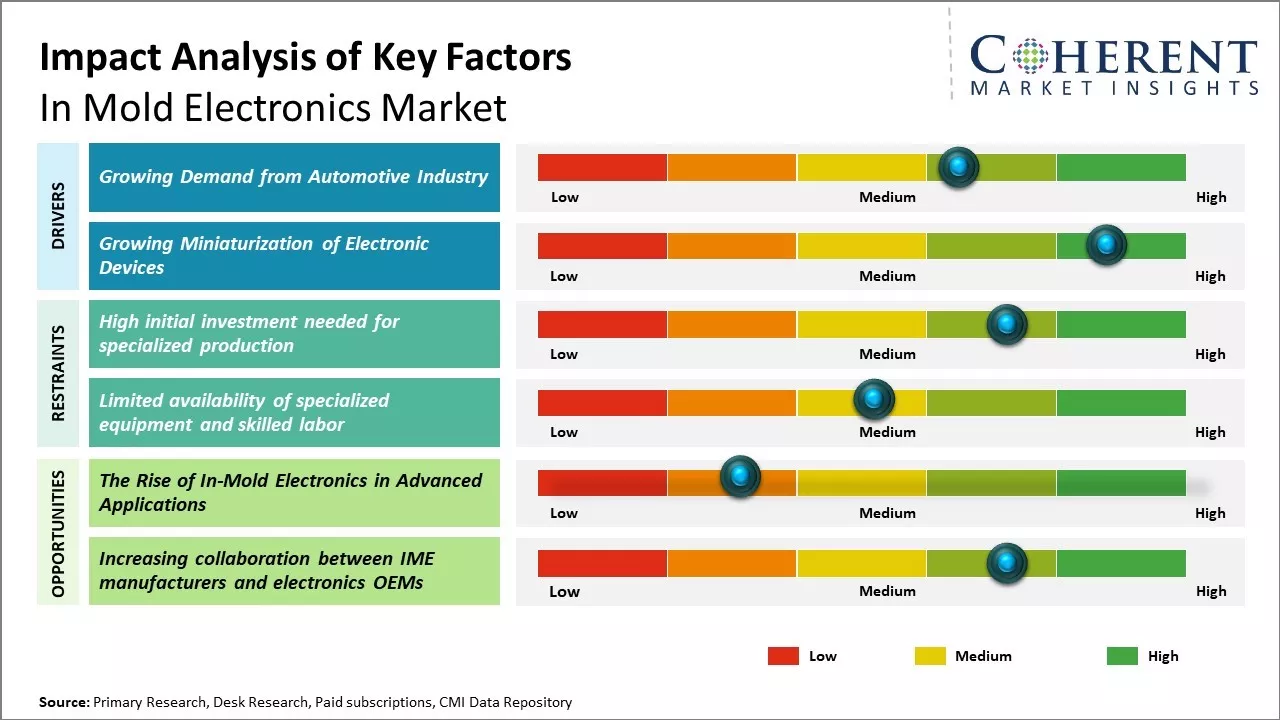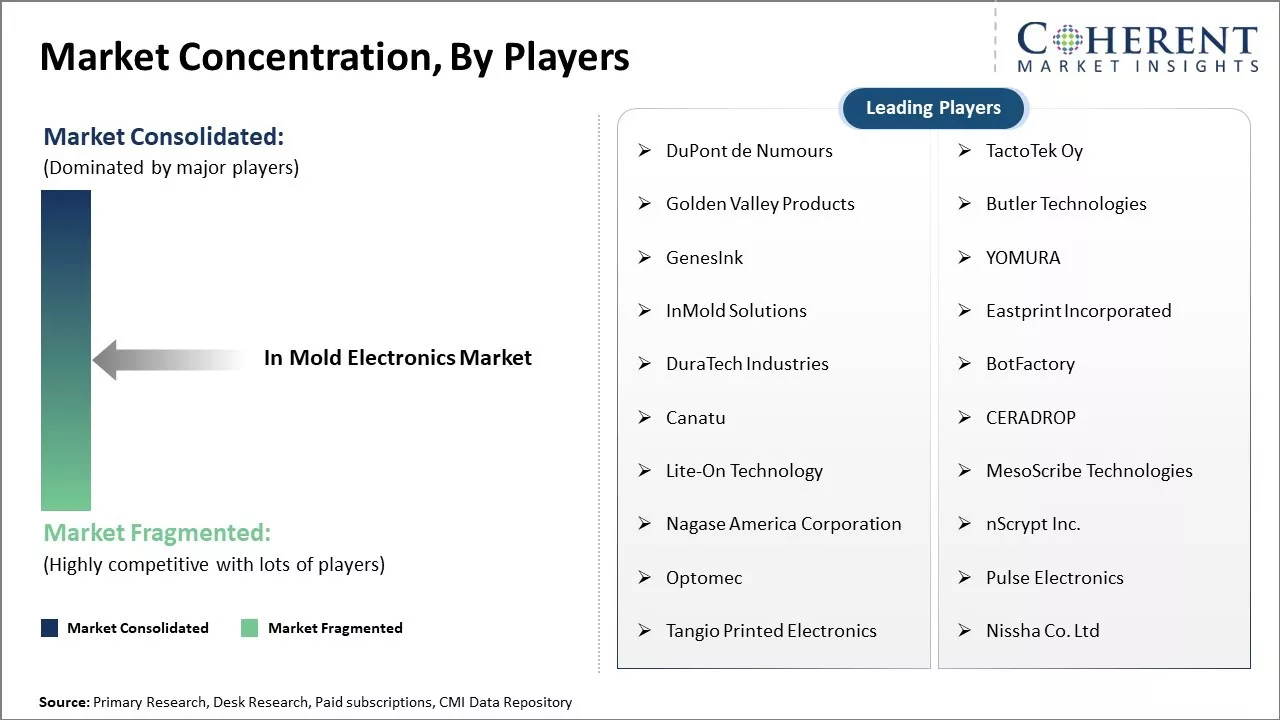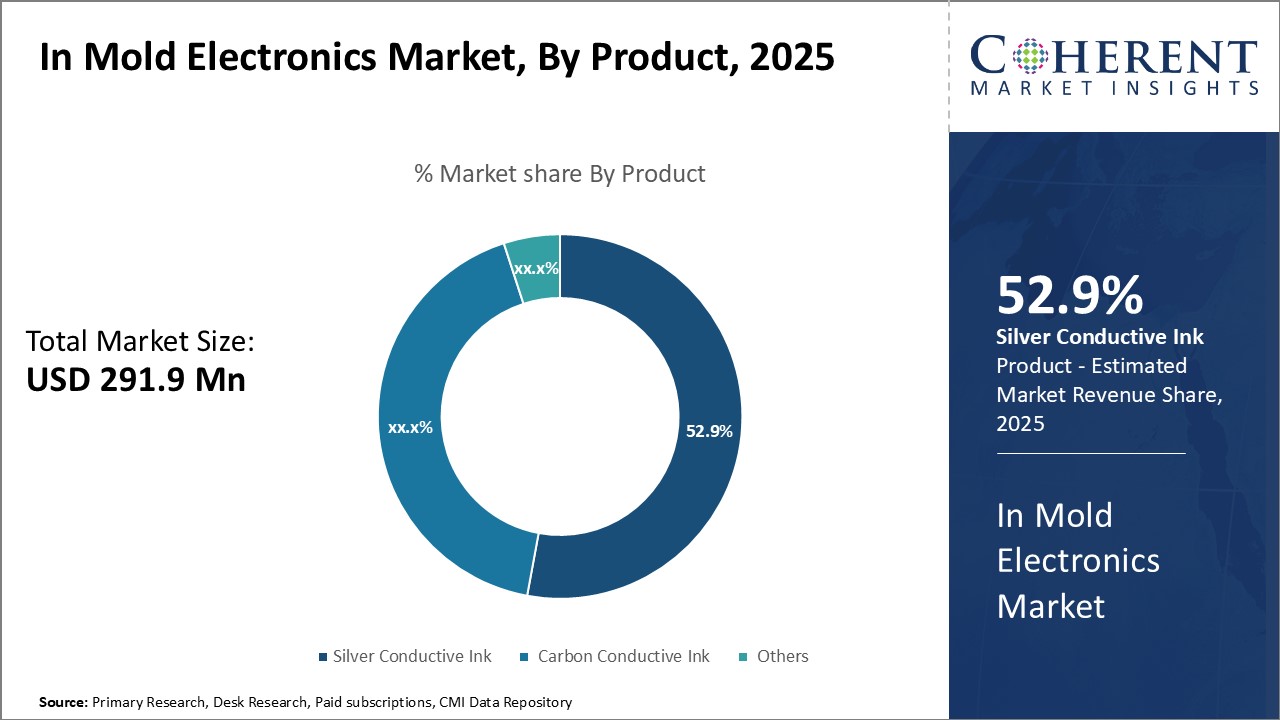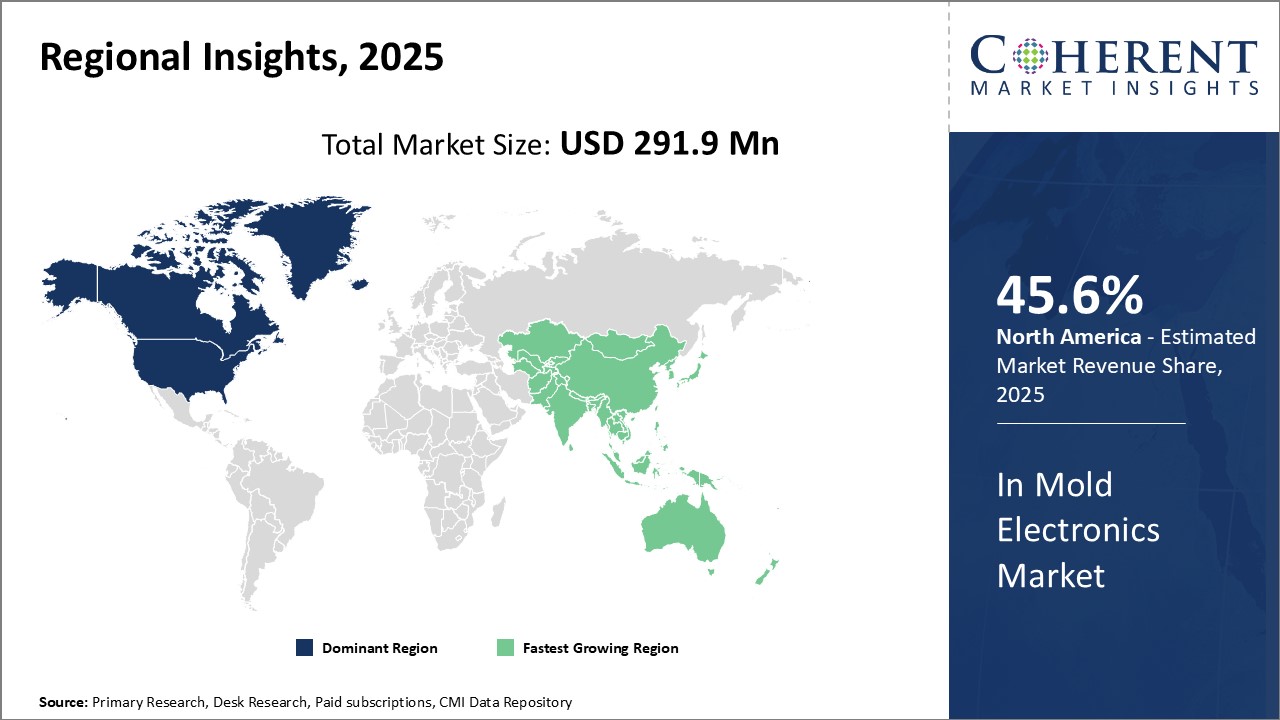In Mold Electronics Market Size and Trends
The In Mold Electronics Market is estimated to be valued at US$ 291.9 Mn in 2025 and is expected to reach US$ 1,608.4 Mn by 2032, exhibiting a compound annual growth rate (CAGR) of 27.6% from 2025 to 2032.

Discover market dynamics shaping the industry: Download Free Sample
The market is expected to witness significant growth during the forecast period. The rising demand for lightweight and cost-effective products across various end-use industries along with the increasing adoption of IoT and connected devices is expected to drive the demand for in mold electronics. Adoption of in mold electronics help manufacturers reduce additional production cost, assembly time and minimize waste during the production of electronic devices. Ongoing technological advancements in the field of printed electronics, such as the development of new conductive inks, is further expected to provide growth opportunities for in mold electronics manufacturers over the coming years.
Growing Demand from Automotive Industry
The automotive industry has been one of the major adopters of in mold electronics technology. In mold electronics allows integrating electronic components such as sensors, antennae and illuminated logos directly into plastic vehicle parts during the injection molding process. This method has advantages compared to traditional methods. It removes the need for extra assembly steps after molding, simplifying the manufacturing process. It also allows for better integration of electronics with vehicle structures, enabling new and creative uses.
Several new vehicles unveiled in recent years featured innovative usage of in mold electronics. Advanced driver assistance systems like lane departure warning, adaptive cruise control and emergency braking rely on various sensors integrated into bumpers and other body parts. In mold technology allows seamlessly embedding these sensors during production. LED lights and illuminated vehicle badges integrated into exterior plastic trims using this technology are also becoming common. With autonomous driving gaining momentum, in mold electronics can facilitate tight integration of various sensors required for proper functioning of self-driving systems.
Regulations mandating safety features like backup cameras are also driving automotive manufacturers to explore in mold electronics. Integrating camera modules directly into tailgates or license plate housing addresses reliability issues associated with detachable camera units. As autonomous, connected and electric vehicles gain wider acceptance, the level of electronics and amount of sensors in vehicles is expected to multiply tremendously. This puts the spotlight on in mold electronics that enables simplified assembly of vehicles with high electronic content. The growing electrification of automobiles is another driver, as in mold technology supports novel approaches to integrating electronic controls and displays. With its ability to enable innovation and help comply with regulations, in mold electronics is sure to play a pivotal role in automotive industry's transformation in coming years.
Market Concentration and Competitive Landscape

Get actionable strategies to beat competition: Download Free Sample
Market Driver: Growing Miniaturization of Electronic DevicesRapid advancements in semiconductor technology and wireless communication standards have led to relentless miniaturization of electronic components in past few decades. Consumer gadgets like smartphones and wearables are now packed with myriad sensors, chips, antennas and other miniature modules. While this allows unprecedented functionality in small form factors, assembly of these heavily packed printed circuit boards is challenging using conventional methods. In mold electronics addresses this problem by integrating electronic modules directly into device casings and structures during injection molding process.

To learn more about this report, Download Free Sample
Market Challenges: High initial investment needed for specialized productionOne of the main challenges the in mold electronics market faces is the high initial investment needed for specialized production machinery and processes. As this technology is still emerging, the costs associated with product development and equipment can be sizable. Additionally, there are technical difficulties to integrate electronics into molded structures while ensuring performance and durability standards are met. Material compatibility between electronics and moldable substances also presents a challenge that manufacturers must solve.
Market Opportunities: The Rise of In-Mold Electronics in Advanced Applications
As technologies advance, the complexity and functionality of potential in mold applications is increasing. This opens the door for incorporating more advanced electronic systems into previously unconnected product areas. The potential for cost reductions through integrated designs and streamlined manufacturing also makes in mold electronics an appealing option for several mass-produced consumer and industrial goods. Continued innovations are expanding the possibilities for using this integration technique.

Discover high revenue pocket segments and roadmap to it: Download Free Sample
Insights, By Product- Silver Conductive Ink holds the highest share of the market owing to its unmatched electrical conductivitySilver conductive ink is estimated to hold the largest share of 52.9% in 2025 of the product segment due to its superior electrical conductivity properties. As the primary component for many in-mold electronic applications, a highly conductive material is vital for ensuring optimal device performance. While other materials like carbon conductive ink offer cost advantages, none can match silver's ability to efficiently transfer electrical signals.
This high conductivity stems from silver's position as the best electrical conductor among all metals. Its atomic structure makes it optimally suited to allowing free flow of electrons with minimal resistance. As even microscopic imperfections can impact conductivity in In Mold Electronics, silver offers extremely smooth and uniform signal transmission at the microscopic level. Its stable crystalline structure also shows little degradation over time from flexing, bending, heat or other environmental factors that electronic components may encounter.
Beyond its intrinsic material properties, silver conductive ink benefits from wide commercial availability and established manufacturing infrastructure. As the gold standard for electrical applications, silver production and R&D have been heavily optimized over decades of use. This ensures consistent and scalable sourcing of high purity silver that precisely meets the demanding tolerances of In Mold Electronics. Mature manufacturing supply chains guarantee just-in-time delivery of silver conductive ink to device producers. Overall, silver's unique ability to maximize electrical performance while minimizing cost and complexity has made it the preferred solution for the majority of In Mold Electronics applications to date.
Insights, By Component- Sensors holds the highest share of the market driven by demand for real-time feedback
Sensors is estimated to represent the largest component segment within the In Mold Electronics market with 45.2% in 2025, as a growing array of applications require real-time feedback on environmental variables. Devices across industries like automotive, home appliances and more rely on embedded sensors for functions like presence detection, environment monitoring, safety features and more. As in-mold technology enables placement of sensor circuits directly within end products at low cost, this demand has propelled sensor components to become the leading package type.
Key priorities driving sensor popularity include performance gains, size reductions and integration benefits. In-mold embedded sensors allow precise and continuous monitoring without compromising aesthetics or usable space. Their direct incorporation during manufacturing also cuts costs versus surface mounting sensors after molding. Interactive functions increasingly require arrays of differentiated sensor types like touch, motion, light, chemical and others - capabilities uniquely supported by in-mold fabrication techniques.
Looking ahead, opportunities in emerging applications and technologies will sustain strong sensor demand. Areas like smart cities, IoT, robotics, augmented reality and autonomous systems all depend on distributed sensor networks for awareness of their environment. In-mold’s single-piece construction is uniquely suited to embedding multitudes of low-cost homogenous and heterogeneous sensors across these next-generation solutions. As real-time sensing and feedback emerge as core capabilities, the in-mold sensor component segment is poised to continue outpacing other options.
Insights, By Application- Consumer Electronics holds the highest share of the market fueled by desire for interactive features
The consumer electronics application segment is estimated to hold the largest portion of the in mold electronics market with 37.6% in 2025, propelled by demand for engaging interactive features among users. As consumer devices evolve from static displays into multifaceted hubs, in-mold manufacturing enables realistic user interfaces that immerse users in new ways. Integrating controls, sensors and connectivity circuits directly into molded casings allows seamless interactions that traditional surface mounting cannot replicate.
From smartphones to wearables to household appliances, users now expect intuitive, contextualized experiences personalized to their needs and surroundings. In-mold facilitates novel form factors that place interactive areas across multidimensional surfaces, unlocking more natural gestural and contextual inputs. Curved edges, invisible controls and adaptive personalization become possible. This level of responsiveness keeps consumers engaged with their devices instead of viewing them as passive tools.
Continuing miniaturization of electronic components also supports in-mold’s thin, conformal circuit placement within many consumer products. Shared manufacturing processes benefit from economies of scale to pass cost savings onto price-sensitive consumers as well. As personal technologies assume more integrated, immersive and assistive roles in daily life, in-mold electronics empower consumer brands to prioritize the user experience over all other considerations - the surest way to drive ongoing market leadership. Therefore, the consumer segment is predicted to remain the primary application driver for some time to come.
Regional Insights

Need a Different Region or Segment? Download Free Sample
North America has established itself as the dominant region in the global in mold electronics market and is estimated to hold 45.6% market share in 2025. With the presence of key industry players as well as OEMs, the region enjoys tremendous manufacturing capabilities which has enabled the early adoption of InMold technology across sectors like automotive, consumer electronics, and healthcare. The automotive industry in U.S. and Canada has been at the forefront driving the technological shift towards connected and autonomous vehicles, thereby increasing the integration of advanced electronics. Several prototyping and mass production facilities for InMold electronics have come up to cater to the growing design and production requirements of automakers. The region also benefits from strong manufacturing infrastructure and supply chain ecosystem for electronics as well as plastics processing.
The Asia Pacific region has emerged as the fastest growing market for InMold electronics globally. China, in particular, is spearheading this growth on the back of a burgeoning domestic market for consumer electronics and automotive sectors. The Chinese manufacturing industry has embraced Industry 4.0 strategies which involves the increased usage of sophisticated technologies like InMold electronics for incorporating value added features in mainstream products. This has translated into massive opportunities for global as well as domestic InMold electronics providers. Furthermore, countries like South Korea and Japan are also contributing significantly as they aim to deploy innovative automotive electronics to gain a competitive edge. The regional export potential is maximized by China due to availability of low cost skilled workforce and favorable business environment for electronics manufacturing.
This regional analysis covers the dominating as well as the fastest growing region for InMold electronics market without providing any numeric figures. It highlights key industry and market factors contributing to their leading positions by covering parameters like manufacturing infrastructure, technology adoption, export outlook and supply chain environment.
Market Report Scope
In Mold Electronics Market Report Coverage
| Report Coverage | Details | ||
|---|---|---|---|
| Base Year: | 2024 | Market Size in 2025: | USD 291.9 Mn |
| Historical Data for: | 2020 To 2024 | Forecast Period: | 2025 To 2032 |
| Forecast Period 2025 to 2032 CAGR: | 27.6% | 2032 Value Projection: | USD 1,608.4 Mn |
| Geographies covered: |
|
||
| Segments covered: |
|
||
| Companies covered: |
DuPont de Numours, TactoTek Oy, Golden Valley Products, Butler Technologies, GenesInk, YOMURA, InMold Solutions, Eastprint Incorporated, DuraTech Industries, BotFactory, Canatu, CERADROP, Lite-On Technology, MesoScribe Technologies, Nagase America Corporation, nScrypt Inc., Optomec, Pulse Electronics, Tangio Printed Electronics, and Nissha Co. Ltd |
||
| Growth Drivers: |
|
||
| Restraints & Challenges: |
|
||
Uncover macros and micros vetted on 75+ parameters: Get instant access to report
In Mold Electronics Industry News
- In August 2023, DuPont is a company that focuses on providing innovative solutions in various industries, including agriculture, electronics, transportation, construction, and healthcare bought Spectrum Plastics Group, a top player in specialty medical devices. This move expands their offerings in healthcare and boosts their presence in the in-mold electronics market.
- In February 2020, DuraTech is a company specializing in providing durable and reliable solutions across various industries. teamed up with Watlow to launch a new IME temperature controller, marking their entry into this market. This, along with other efforts, helped them capture more market share.
- In December 2023, TactoTek is a company that specializes in providing innovative solutions for the manufacturing of electronic devices. and Yanfeng is a company that specializes in providing interior solutions for automotive manufacturers. joined forces to enhance future vehicle interiors. Together, they are developing advanced human-machine interface solutions for smart cabins, driving growth for both companies.
- In September 2022, Canatu is a company that specializes in providing innovative solutions in the field of transparent conductive films and touch sensors. started making a new flexible touch sensor that can be shaped in 3D. Methode Electronics, Inc., a worldwide supplier of tailored products, is using Canatu's touch sensors in its center stack. This special center stack will be featured in a popular luxury SUV set to debut in September 2022.
*Definition: The In Mold Electronics market involves the integration of electronic components such as sensors, resistors, capacitors, and integrated circuits directly inside molded plastic parts during the injection molding process. This allows electronic functionalities like sensing, lighting, and input/output to be seamlessly embedded within plastic components for end products across various sectors like automotive, consumer goods, medical devices, and more. In mold electronics help streamline design and manufacturing processes while reducing costs and improving product functionality compared to traditional methods of electronics assembly.
Market Segmentation
- Product Insights (Revenue, US$ BN, 2020 - 2032)
- Silver Conductive Ink
- Carbon Conductive Ink
- Others
- Component Insights (Revenue, US$ BN, 2020 - 2032)
- Sensors
- Antennas
- Connectors
- Others
- Application Insights (Revenue, US$ BN, 2020 - 2032)
- Consumer Electronics
- Automobile
- Home Appliance
- Industrial
- Others
- Regional Insights (Revenue, US$ BN, 2020 - 2032)
- North America
- U.S.
- Canada
- Latin America
- Brazil
- Argentina
- Mexico
- Rest of Latin America
- Europe
- Germany
- U.K.
- France
- Italy
- Russia
- Rest of Europe
- Asia Pacific
- China
- India
- Japan
- Australia
- South Korea
- ASEAN
- Rest of Asia Pacific
- Middle East & Africa
- GCC Countries
- South Africa
- Rest of Middle East & Africa
- North America
- Key Players
- DuPont de Numours
- TactoTek Oy
- Golden Valley Products
- Butler Technologies
- GenesInk
- YOMURA
- InMold Solutions
- Eastprint Incorporated
- DuraTech Industries
- BotFactory
- Canatu
- CERADROP
- Lite-On Technology
- MesoScribe Technologies
- Nagase America Corporation
- nScrypt Inc.
- Optomec
- Pulse Electronics
- Tangio Printed Electronics
- Nissha Co. Ltd
Share
Share
About Author
As an accomplished Senior Consultant with 7+ years of experience, Pooja Tayade has a proven track record in devising and implementing data and strategy consulting across various industries. She specializes in market research, competitive analysis, primary insights, and market estimation. She excels in strategic advisory, delivering data-driven insights to help clients navigate market complexities, optimize entry strategies, and achieve sustainable growth.
Missing comfort of reading report in your local language? Find your preferred language :
Transform your Strategy with Exclusive Trending Reports :
Frequently Asked Questions
EXISTING CLIENTELE
Joining thousands of companies around the world committed to making the Excellent Business Solutions.
View All Our Clients
